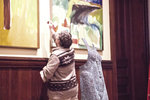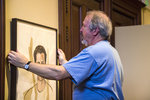Artist Stephen Yates remembers being blown away when someone from Port Townsend showed up to see his solo show in Seattle.
“It was one of those things where you don’t expect somebody to make …
This item is available in full to subscribers.
We have recently launched a new and improved website. To continue reading, you will need to either log into your subscriber account, or purchase a new subscription.
If you had an active account on our previous website, then you have an account here. Simply reset your password to regain access to your account.
If you did not have an account on our previous website, but are a current print subscriber, click here to set up your website account.
Otherwise, click here to view your options for subscribing.
* Having trouble? Call our circulation department at 360-385-2900, or email our support.
Please log in to continue |
|


Artist Stephen Yates remembers being blown away when someone from Port Townsend showed up to see his solo show in Seattle.
“It was one of those things where you don’t expect somebody to make that effort,” Yates said.
The late Peter Simpson made that effort.
It was with exuberance that Simpson and his wife, Pat, championed Port Townsend’s arts, not only through involvement with major and minor arts organizations, but also by supporting individual artists.
“They were always so encouraging,” Yates said of the couple. Both of them have since died.
The Simpsons attended gallery openings and purchased pieces from local artists, like Yates, over the years building a collection of paintings and sculptures that they later donated to the Jefferson Museum of Art and History.
For the next six months, that collection is on display at the museum in a show titled “Pat and Peter Simpson: Collectors and Patrons.”
The exhibit features works done in the mid-1980s by nine local artists – Yates, Anne Hirondelle, Jo Ann Alber, Kate Jenks, Stephanie Lutgring, Linda Okazaki, Galen Garwood, and the late Tom Wilson and Ed Cain – along with pieces from some of the artists later in their careers, including a large-scale painting by Yates, “Navigator’s Strategy,” done specifically for the current show.
NEA FELLOWSHIPS
For curator Ann Welch, the exhibit represents what it means to support the arts, a message that has even more weight in the wake of President Trump’s proposal to eliminate the National Endowment for the Arts – some of the artists, like Yates and Hirondelle, were past recipients of NEA fellowships and awards.
“It’s been a tough winter on many levels,” Welch said. Working on the exhibit offered a joyful way to celebrate hard- and long-working local artists, she said.
By displaying more contemporary art alongside older pieces, the exhibit demonstrates how the artists’ works progressed over the years, and how encouragement engenders more art.
“This exhibit reflects – once again, even after Peter’s passing – his encouragement of the arts and what he continues to add to the cultural landscape of art,” said Welch.
Many of the artists whom the Simpsons supported were at times living pretty close to the bone, Welch said.
“The support that you get from someone buying a piece makes a huge difference,” Welch said. “We can see in this exhibit what these small purchases meant to each one of the artists.”
The late Tom Wilson was one of those penniless artists; he painted portraits of friends and patrons like the Simpsons in exchange for food or other necessities. They also exchanged ideas.
“It was a very rich, cultured environment,” said Welch, who knew the “warmth and supportiveness” of the Simpsons firsthand: Her parents were friends with the artistic bunch; Wilson painted her portrait when she was a young girl; and Peter Simpson encouraged her artistic endeavors.
Ceramist Anne Hirondelle – whose art is in private and public collections across the state, including The White House Collection at the Clinton Presidential Center and the Museum of Arts and Design in New York City – was also close with the Simpsons.
“I cut Peter’s hair for years,” Hirondelle said. “We traditionally had Thanksgiving dinner with them.”
The Simpsons bought her pieces over the years and supported her as her art style changed. “As an artist, when someone responds to your work and is willing to buy it, that’s an affirmation,” she said.
EVERYTHING IN ITS PLACE
When the historical society began to plan for the show, Welch knew they had to have the assistance of Suzanne Lamon in laying the pieces out in the museum gallery.
“[She’s] really extraordinary at laying out an exhibit,” Welch said of the artist. “She can be a little maddening,” she added, laughing.
Welch recalled a time when she had laid out a past exhibit and invited Lamon to look at it.
Lamon moved every piece but one.
“And then it became 10 times better,” Welch said. “She has this way of putting things together that just sings.”
“We lay it around and we move it and move it and move it,” Lamon said of how she works, noting that the specific placement of Hirondelle’s two newest pieces is something she insisted on and was the final thing that made the show “sing.”
The shapes and colors of the ceramic pieces harmonize especially well with the large-scale work Yates painted specifically for the exhibit, something that wasn’t intentional, but was perhaps intuitive – Yates and Hirondelle have shown their work together before.
The color palette of Yates’ painting also coordinates with Wilson’s portraits of the Simpsons.
“What’s been amazing about that particular painting is it’s tied everything together,” said Welch.
“Stephen’s painting is the one that made everybody else work,” Lamon said, noting the challenge of taking pieces from a private home and trying to lay them out cohesively in a gallery setting.
ART MUSEUM
The Simpson exhibit also represents the museum’s increased focus on Port Townsend’s identity as an art community.
“It’s a direction we’re moving toward,” said Welch. “We’re still trying to convince the town that we’re an art museum,” not a dusty history museum, she said.
While the Jefferson County Historical Society has collected art since its establishment in 1879, the bequest of a major art collection from Nora Porter in 2011 inspired an increased emphasis on the arts. The following year, the Jefferson Museum of History’s name was changed to the Jefferson Museum of Art and History.
The museum now has a bright gallery space for the fine arts, and hosts two shows a year. “We’ve done some boffo shows,” Welch said.
The museum has also published a comprehensive book to accompany the exhibit. The illustrated book offers biographies of all the artists involved, and includes in-depth essays on the Simpsons and their involvement with art community: Peter Simpson either worked or volunteered for the film festival (where he was a longtime director), Copper Canyon Press, the Port Townsend Arts Commission, the Jefferson County Historical Society, the Washington State Historical Society, The Leader and the Northwest Maritime Center. Pat Simpson was director of development at Centrum.
“If we could imagine what it would have been like here without them, the town would have been quite different,” said Mary Coney, who cowrote the book with Jenny Westdal.
“Because the Simpsons observed and participated in the arts in Port Townsend for 50 years, this was a perfect opportunity to research and record an overview of the art-related history that brought us to where we are now,” Westdal said.
A NEW PERSPECTIVE
Reflecting on the show and how the Simpsons’ support encouraged artists to keep creating, Welch hopes people in the community can be inspired to support the arts in any way possible.
“Even if you can’t buy any artwork, you can tell an artist that they’re doing well,” Welch said.
“Tell artists over and over in whatever way you can that their work is valuable.”
Art illustrates the wonder, bewilderment and joy of the human experience, she said, and can give us a new perspective.
“Even if you don’t like it, it makes you think about it.
“If we take the time to look and experience the work, perhaps we can see through another’s eyes how they see the world.”
The Jefferson Museum of Art and History, 540 Water St., is open from 11 a.m. to 4 p.m. daily. Admission to the museum is free for locals on the first Saturday of every month.